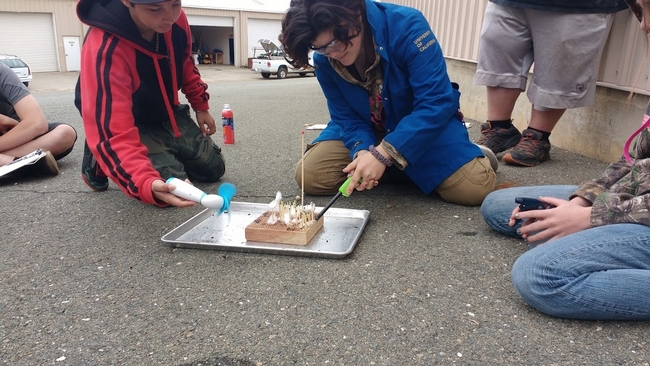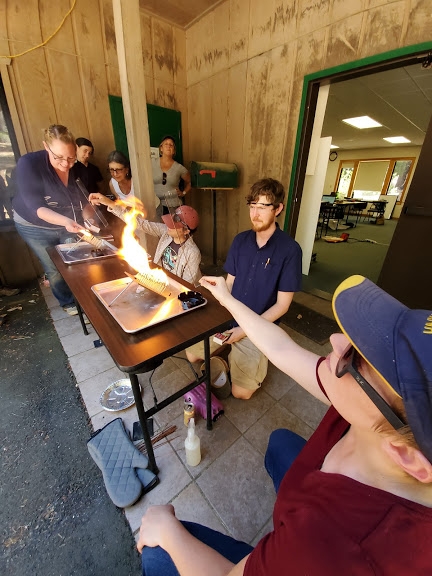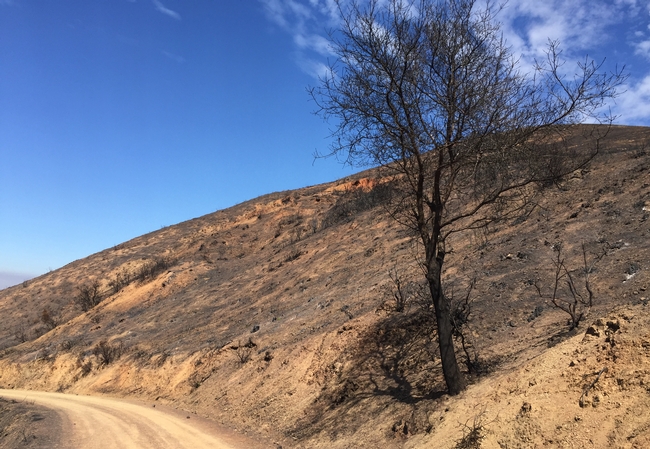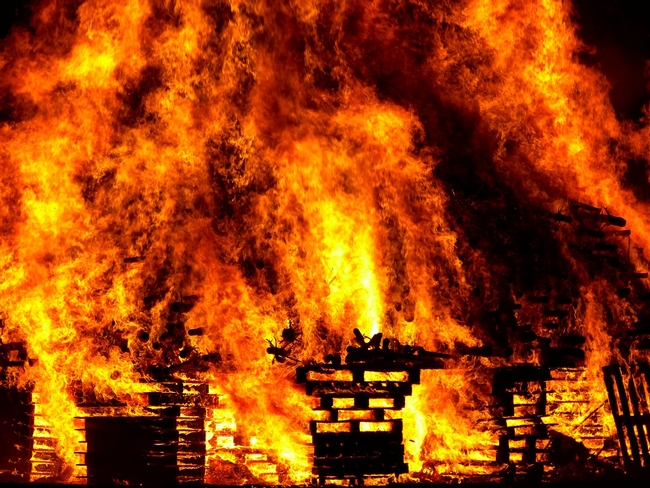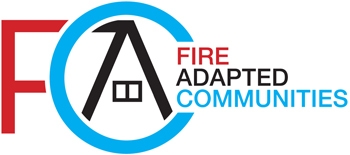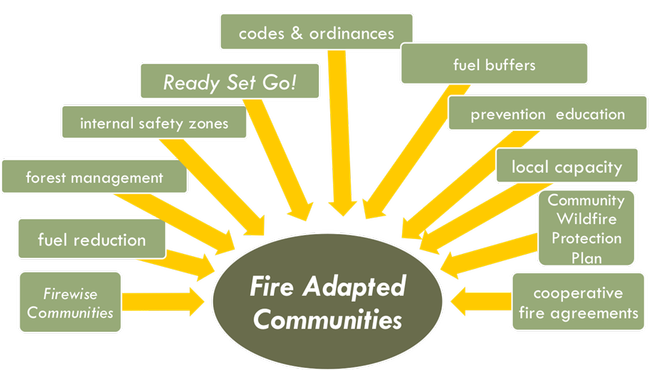Posts Tagged: fire-adapted community
To prepare Californians for wildfire in oak woodlands, UC ANR offers teachers training
California's most destructive wildfire year on record was 2018, with devastating fires occurring in Northern California oak woodlands. From 2015 to 2017, six of California's 20 most deadly and destructive fires in history occurred in these areas. The communities living in oak woodlands, which had been mostly spared from previous wildfires, were largely unprepared.
To prepare Californians to live with wildfire, Kate Wilkin, former UC Cooperative Extension forestry/fire science and natural resources advisor, and UC Sierra Foothill Research and Extension Center and Hopland Research and Extension Center community educators Alexandra Stefancich and Hannah Bird received a $100,000 Environmental Protection Agency Environmental Education grant.
In addition to delivering community workshops, the educators will offer online training for teachers this summer. The curriculum will be introduced by webinar on Tuesday, July 14, from 11 a.m. to 11:30 a.m. (PDT). Register online for this free webinar at https://bit.ly/firecurriculum.
“The goal of this project is to educate youth and adults about their natural ecosystems and how to reduce the risk of catastrophic wildfire,” Stefancich said.
Even before the current COVID-19 pandemic constrained activities, challenges arose: the federal government shutdown delayed the grant; a wildfire burned approximately two-thirds of the Hopland REC; Wilkin moved on from UCCE and Rebecca Ozeran, UCCE livestock and natural resources advisor, took over leading the wildfire education project.
Training kids, adults and communities
The team is educating children, adults and communities. Their three-pronged approach includes youth education for 500 middle school students and training for teachers; adult education through advanced training for California Naturalists; and community education by partnering with Fire Safe Councils in Butte, Mendocino and Yuba counties.
“One of the most exciting aspects of this grant has been the youth fire education component,” Bird said. “The grant has funded an adaptation of theUS Forest Service's FireWorks Curriculum – first modeled for Rocky Mountains forests – to the California oak woodland ecosystem. This hands-on, place-based science curriculum aims to provide students an in-depth understanding of fire science. In working on this curriculum, the team wants to highlight the importance of not only oak woodland fire science, but the cultural history associated with fire on these landscapes.”
The grant allowed the team to work with local representatives from the Hopland Band of Pomo Indians, Kashia Band of Pomo Indians, United Auburn Indian Community and the Nevada City Rancheria to develop lessons shaped by the cultural value of fire as a tool and the long relationship between people and fire in California.
While developing the lessons, the team realized the importance of trauma-informed educational practices.
“Just five years ago, we often talked about wildfire theoretically, but now every student I speak with has their own experience to share,” Bird said. “It is important to give time in the lessons for the trauma experienced by our youth, and to educate them and encourage a sense of agency. These lessons focus on the positive! We don't spend time on things that we cannot change. We learn crucial concepts of fire science and build on them to make our schools, families and communities more fire prepared.”
Feelings about fire
The team piloted the new curriculum with more than 150 middle school students in Redwood Valley and Ukiah, just before schools closed due to the COVID-19 pandemic.
“Trialing the curriculum with students was really valuable,” Bird said. “These students have seen their communities affected by wildfire and it brings up many emotions for them.”
Students were asked to share their thoughts around fire at the beginning of the lessons and again at the end of the lesson series. Feelings of fear were replaced with feeling prepared and confident.
Before the lessons, students' comments about fire included, “Scary because I live in the mountains and my house is there, it could burn down.”
After the lessons, their comments included, “I felt positive about this, I feel that I know what to do, I think everyone should know how to prepare for fire.”
Pomolita Middle School students made an action plan for their school to help improve school fire preparedness. Students had hoped to present their plans to school administrators, but school closures due to the coronavirus crisis have delayed the presentation.
“Most of what we found at Pomolita school was really positive – the students do have a few suggestions that they hoped to share with the school administration,” Bird said. “Students also made an emergency contact plan and planned what they would like to have in a go bag for themselves and for their pets.”
Community educator Stefancich added, “This curriculum, aimed at middle school students, is ideal for any educator hoping to provide their students with more insight about the role fire plays in the ecosystem and how they can prepare for its eventuality. Each lesson is set up for the lay educator to be able to teach, so even without advanced fire knowledge it will be easy to use.”
The team continues to adapt the FireWorks curriculum for oak woodlands and expects it to be available at the FireWorks site https://www.frames.gov/fireworks/curriculum/overview by the fall.
Becoming a fire-adapted community
The magnitude of wildfires especially affects those communities that are part of the wildland-urban interface (WUI). Many communities, whose back doors open out into conifer forests, shrub fields or grasslands, have been working towards becoming more resilient and proactive about wildfire. One way is to become a Fire-Adapted Community. A Fire-Adapted Community is a community that can survive a wildfire with little or no assistance from firefighters. The community acknowledges and takes responsibility for this by preparing for a fire at multiple levels including the use of appropriate building construction materials, and proper vegetation management. Members of the community are concerned with safety: safety of the individual, homes and businesses, community infrastructure, open spaces, riparian areas, any and all community assets. They address issues, plan, prepare and work with their local government agencies, fire services and citizenry to reduce their risk if a wildfire comes their way.
There are four elements to a Fire-Adapted Community:
- Community collaboration - Strong fire-adapted communities have a role for everyone. This means that all members of the community (government, schools, businesses, homeowners, renters, fire services, emergency responders, etc.) work together to raise awareness of fire risks and increase knowledge of fire ecology and mitigation actions. This is done through various outreach activities, partnerships and incentives. It also includes completing a Community Wildfire Protection Plan (CWPP) that will assess your community's risk and identify actions to take to lower those risks. It could also involve participating in the Ready Set Go! program which is a collaboration between residents and local fire departments to help people prepare (Ready), understand the threats (Set) and evacuate early (Go) in a fire event.
- Surrounding environment – Fire adapted communities look beyond their fences to see what risks exist and what actions can be taken in the surrounding landscape to reduce those risks. These actions can include fuels reduction projects, improving community ingress and egress and/or the protection and enhancement of riparian and wildlife habitat.
- Planning and regulatory considerations - Fire adapted communities work with their local and state government agencies to ensure that policies, standards and regulations support actions that reduce the risks of wildfire in the community. This may include building codes and standards that encourage the use of non-combustible materials in home construction; the creation of community protection zones that would create a safe environment in the case of resident evacuation; maintaining large turnaround areas for large pieces of equipment; and having a reliable and easily accessible water system.
- Neighborhood, landscapes and buildings - All members of a fire-adapted community work to ensure that their homes, businesses and community assets are prepared in the event of a wildfire. This means reducing flammable materials around homes and businesses; maintaining the immediate landscape and using appropriate, less combustible building and landscaping materials; creating fuel buffers around the community; ensuring that streets and homes are well signed; creating safety zones for residents and animals; having a communication plan – who to call and how to connect if a fire occurs; and designating evacuation routes.
All of these actions taken together, in a collaborative process, help build a strong fire adapted community that is better prepared to face and survive a wildfire.
In the Sierra Nevadas, Incline Village, Nev., is an example of a fire-adapted community. For the past 10 years, they have implemented fuels reduction projects based on their CWPP and involved homeowners and local businesses in planning and implementing mitigation actions. Recently, their goal was to engage a larger audience, build personal connections and recruit new volunteers. Their efforts led to a large gathering where participant input was an essential part of community building and the creation of next steps for the fire adapted community leadership. One participant said that it “Gave me hope that a coordinated, cohesive strategy to prepare our community is seriously underway.”
“I really admire the many active citizens in communities throughout the Sierra Nevada working to reduce wildfire hazards in their neighborhoods," said Susie Kocher, UC Agriculture and Natural Resources forestry and natural resources advisor. "It really will take all of us working together to help our communities become adapted to wildfire.”
Becoming a fire adapted community also means joining a network of people and projects. The Fire Adapted Communities Learning Network is a repository of information and encourages the development and sharing of ideas that can help your community build capacity, raise awareness and take actions towards wildfire resiliency.
For more information on becoming a fire adapted community, or other items mentioned in this blog, please visit:
- Lessons in Community Engagement from North Lake Tahoe
- Becoming a Fire-Adapted Community
- CWPP process
- Fire-Adapted Communities Learning Network
- A Guide to Fire-Adapted Communities
- UCCE Nevada's award winning program
Images courtesy of the National Fire Protection Association.


